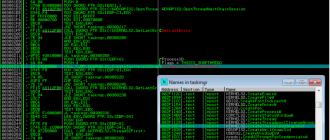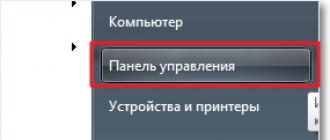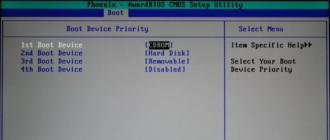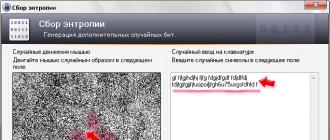Problems with hard drives on your computers always arise spontaneously. The main indicator possible problems from HDD - time! Yes, time is not only a “doctor”, but also an absolute destroyer!
Signs that indicate problems with the "tin" - very banal.
First, these are strange sounds that occur while your hard drive: scratches, clank and other sound effects.
Secondly, it is heating the surface of the hard drive case: as you know, a normal HDD does not heat up at all (well, its maximum surface is slightly warm).
Thirdly, frequent "gatherings" of the operating system: this indicates a huge number of damaged sectors of your hard disk (clusters).
As you can see, friends, there are a lot of reasons. How to solve a problem? There are two solutions:
- buy new hDD;
- try to “cure” the old one.
Recover bad hard disk sectors
For starters, you should know the causes that catalyze the occurrence broken sectors on HDD:
- improper shutdown of the computer;
- viruses and Trojans;
- incorrect removal of programs and games.
How to do it? There is nothing complicated in the procedure, since it is as simple as a penny. Go to the "Start - My Computer." Direct the cursor to any local disk and click the right mouse button. A menu will pop up in which you select the last line “Properties”. Clicking on "Properties", you open the "Properties: system disk (drive letter) ". In the same place, in this window, you see several active tabs - click on the “Service” tab. See: there are three sections and there are active buttons in each section? In the section "Checking the disk (Checking the volume for errors)" click on the button "Perform a scan", and then put the "birdies" in the items "Check and repair bad sectors" and "Automatically fix system errors".
Next, click on the "Run" and wait for the end of the process. Warning: the process of troubleshooting hard disk can take a very long time! It directly depends on the state and "age" of your hard disk. Therefore, do not panic if your disk is “cured” for several hours in a row: this is normal for old or badly beaten HDDs. Caution: if your broken disk (for example, C) is busy at the moment, the OS will prompt you to check the sectors at the next system boot. We agree, click "OK" and restart the system. Everything: now your disk has started to be “treated”. You only need to wait for the end of the process. After that, we check the disc for adequacy: we try to run programs and applications, and monitor the speed and quality of performance. But still, it should be noted that the old hard drive sooner or later, but be sure to be covered with a "copper basin"! Therefore, if your HDD is old, be prepared to replace it. Good luck!
Consider restoring hard drives improvised means at home. In fact, in most cases, the hard drive is flying due to the abundance of the so-called “bad sectors”. If they are cleaned, the hard drive can last for a very long time. The easiest way to check the "screw" for the presence of "bedov", to test using standard diagnostic methods of the Windows operating system. In the functions, you can choose two ways to check the disk and wait ... After you finish hard recovery drive, in theory, should be successful.
Another standard tool is the defragmenter, which began to go in the delivery of Windows operating systems, starting with windows versions 98. The principle of operation of this tool is quite simple, but, as a rule, very effective. When working, this tool collects all the “bad sector” in a pre-reserved space on the hard disk. It turns out that they are not “treated”, but are blocked and do not interfere with the full work of the hard drive. The minus of this method is the occupied space on the hard disk.
Over time, the number of broken clusters accumulates and, accordingly, the space allocated for them gradually increases, which, frankly, is not at all correct. Therefore, in order to carry out normal, full hard drive recovery, third-party developers began to develop alternative ways better hard drive recovery.
So there were such proven software products as HDD Regenerator and "Victoria". Thanks to its algorithms, these programs restore bad sectorsrather than blocking them. Thereby free place on the hard disk is saved, and is not reserved for unknown needs. Let's pay a little attention to the utility "Victoria". This program conducts low-level hard drive diagnostics, so that the recovery of hard drives is as successful and fast as possible.
The utility is absolutely free. There is support for IDE and SATA interfaces. The disadvantages can be attributed to the lack of desktop, only works from under MS-DOS with boot disk. It has a sector-by-sector recovery mode for clusters on the hard disk. It can test the position of the heads, which is important to maintain the normal performance of the hard disk after recovery.
Today we will get acquainted with one of the simplest and, at the same time, one of the most powerful programs, to diagnose and repair a damaged hard drive at a low level - HDD Regenerator
Low level of work with hard drive means that the program will have exclusive access (usually the DOS environment is used) not only to the hard drive, to its sectors and clusters, but also to the controllers and mechanisms that are involved in hard work disk.
Also, at a low level, the file system of the disk and format problems are ignored (the failure of the system disk records).
The program gained its popularity in computer service centers by the fact that, unlike many similar programs, it really restores bad sectors by reversing them.
Other programs simply close access to the cell in which the necessary piece of information to the file could be located. On the one hand, this is good, as it allows you to quickly bring the HDD (hard disk) in working condition by deleting non-working sectors in the disk.
On the other hand, with this approach, you lose not only the information that was stored in these sectors, but also the volume of your disk. If you have a bit of broken sectors up to 100, then we strongly recommend using the software product from Dmitriy Primochenko “HDD Regenerator”.
The latest versions of HDDR are paid, but it is from the series of programs that can recoup the funds invested in it at once. In addition, this program has a demo mode, which we will use to show you how it works.
The same program allows you to diagnose the disk.
So, how to use the program HDD Regenerator.
For the example of working with HDDR, we will use version 1.7, which hardly differs from version 2011 and works as good on win7 as on XP.
Download from the official site http://www.dposoft.net demo version of the program.
“Try” button.
Install and run.
After installation, you can Russify the program by downloading the file: “HDD Regenerator Rus”. However, Russification translates only the starting interface of the program. And since all the work of HDDR occurs in DOS or in its emulation (in the Windows system), you will still have to face english language. But we will help you.
Suppose we need to test and restore the hard disk. Click not the top of our window in the place where it says "Click to ...".
In some cases, a warning window may appear: IMPORTANT!

This warning states that as a result of the HDDR check, it was established that your SATA controller is running in ANCI mode and you are asked to reboot and fix it in IDE mode in the BIOS.
If for you these are unfamiliar words, then it is better to refuse. the program will still work, but a little slower.
In the next window, the program will find and identify the disks connected to your computer. In our case, HDDR identified 1 Samsung HM251Ji hard drive with the number of sectors 488 billion.
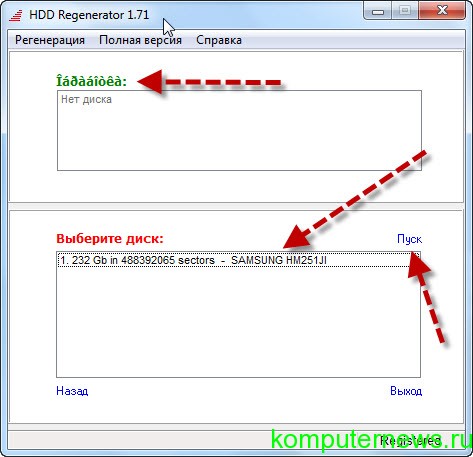
Do not be intimidated by such a number of sectors, the program is testing the working sectors quickly enough.
The word above with broken coding means “Selected Discs”. The disks are selected with the mouse button from the bottom window “Select a disk”. After the line with the disc description becomes active, press the start button or double-click to activate the disc description.
The program will attempt to run DOS emulation. What is DOS emulation? In short and simple language, DOS is a working environment (text-based operating system) for direct access to computer hardware in the Windows system. Also used by some old or specific programs.
If you run the program in the Windows system, then most likely you will receive the following message:

This is a warning that HDDR was not able to gain exclusive access to the virtual partitions on the C, D, E drive, due to the fact that some programs use them. You are invited to close all windows and running programs and repeat (Retry) launch.
If it does not work, try to reboot and repeat. In case of a repeated error, try manually closing processes that were not started on behalf of the system through the Task Manager, or you can try to do the same in Safe mode - “ Safe mode"(F8 button when the computer starts).
In extreme cases, you can ignore this warning and click on "OK".  In our case, we will do it this way, as this will only further complicate the work of HDDR, but it will still work.
In our case, we will do it this way, as this will only further complicate the work of HDDR, but it will still work.
In the next window, HDDR will report that it could not get exclusive access to hard disk 1 (in our case, Samsung), but it will still try to start working with it.

Let's consider its interface in more detail.
1. Scan and repair
- Test (Scan) and repair (repair) your hard disk.
2. Scan, but not repair (show bad sectors)
- Scan, but not restore, but only show bad sectors.
3. Regenerate all sectors in a range (even if not bad)
- Restore all bad sectors in the range of "from and to". For example, start testing with 200 billion sector and finish with 320 billion. (What is it, you will understand a little later)
4. Show statistics
- Show statistics on working with the disk. It will be available only after the process of testing or regeneration of the disk.
If you launched HDDR for the first time, then it is better to select item 2 first. In the Enter choice place, simply enter the number “2” from the keyboard. If the number is not entered, activate the DOS window with the mouse and repeat the input.
The following window will open.

Here you are asked to start testing the disk not from 0 (by default), but from a certain place on the hard disk.
For example, we have a 230 GB disk divided into 3 sections, each of which is approximately 70 gigabytes. And only in the third section, we noticed a freeze, extraneous sounds (or other reasons) saying that “something is wrong” is happening with the disk. Accordingly, we divide our 488 billion by 3 and enter the resulting number, rounded down. That is, we save time.
Or you can use the second (indicated at the bottom of the window) option, by which you can simply enter the size of the disk from which to start testing and press the M button (English layout). The "M" button will add a suffix to the number indicating that we use MB.
If we want to start the disk check from the very beginning, we just press Enter.
In the next window, the disk testing process begins. As the disk passes, it will display information about how many sectors it went through and how many found broken (damaged) sectors.

It will also determine the extent of their damage. If at some point you want to stop the testing process or pause, press the ESC button.
If at the moment of testing, strange sounds were heard and the system suddenly started to hang, it means that HDD Regenerator has detected bad sectors and uses all computer resources to determine the nature of the damage. Disk operation is disabled at this point, and the system completely freezes.
As you pass bad sector computer work is restored. This is one of the reasons for such an operation to be performed only in DOS mode outside the widows system. How to do this we describe at the very end of the article.
So. After he finds the first bad sectors. The HDDR operating in the “DEMO version” mode will show you the following window.
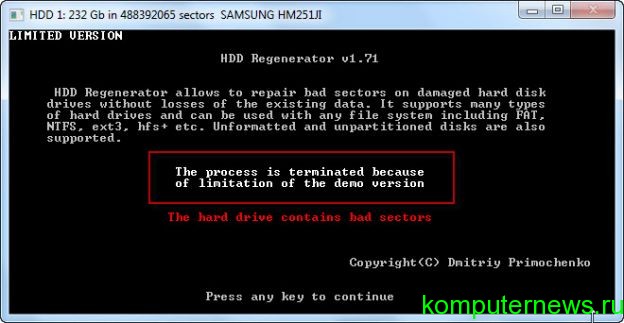
It says that the process is suspended, since you are using a non-registered version of the HDD regenerator. To obtain full version programs, you need to buy a license for it (key) on the manufacturer's website: http://www.dposoft.net
The next window will show us statistics on our disk. This window will show how many sectors are found damaged, how many recovered and how many he could not recover.
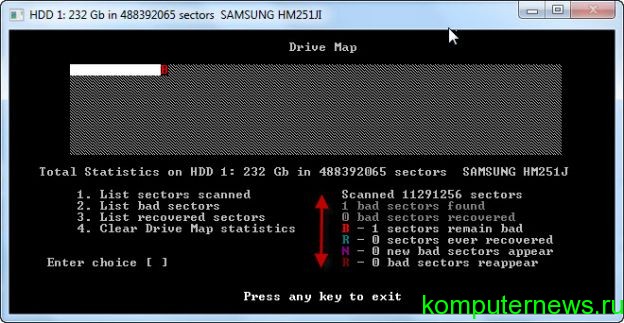
We describe in more detail:
1. List sectors scanned
o List of scanned sectors
2. List bad sectors
o List of bad sectors
3. List recovered sectors
o List of restored sectors
4. Clear Drive Map statistics
o Clear statistics window.
B - damaged sectors
R (green) - recovered sectors
R (red) - sector failed to recover.
The work of the program HDD regenerator in the DOS system.
And now how to run the program in DOS mode, where HDDR will have maximum speed and performance on checking and restoring your disk.
For this you need an empty Flash card. We insert it into the USB socket and run hDD program Regenerator.
Next, click "Bootable USB flash drive ....".
In the window that opens, select the flash drive and click OK.
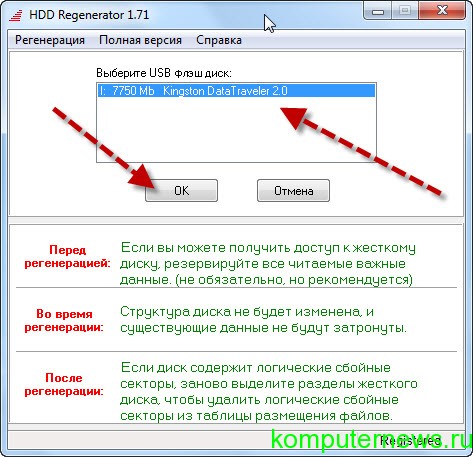
HDDR will remind you that all data on it will be destroyed. Click OK, and then HDD regenerator will format it, and write its files on it, which will first make it bootable, then allow it to run HDDR files on its own.
In the DOS system, you will see all the same windows that were written about in this article. When restoring a disk through DOS, it should be remembered that if you decide to interrupt the operation, you only need to do this through the ECS button and be sure to wait until a window appears asking you to log out of the system again by pressing ESC.
The fact is that when the regeneration process is interrupted, the program records information on the process statistics and the point at which the program was stopped on the USB flash drive.
When the program is restarted, HDDR will start its work from the place where the pause is pressed. Thus, it is possible to recover disks with a large number of broken sectors, the restoration of which requires considerable time.
For example, recovery of 100 problem sectors may take several days of continuous HDDR operation.
Unfortunately, in our time, modern hard drive manufacturers devote more time to its speed and performance volume than its reliability. The warranty on hard drives in our time rarely exceeds 1 year.
Because of this, my personal opinion as the author of the article - I do not recommend storing important information on a single hard disk. It is necessary or duplicate it to another hard disk ( optical discs will not work) or use another more optimal option.
For example, for these purposes, as the use of Internet resources for storing file information, which we will discuss later in another article.
Thanks: Oleg Kuznetsov
In the article we will consider the possibility of restoring a failed hard drive. On how to recover data from a formatted hard disk, you can read. Many are interested in the question: is it possible to restore the hard drive? Let's answer this way: recovering information from a damaged hard disk is possible if its working surface is not damaged. Well, now several effective ways to restore the disk that will help you recover valuable information.
How to recover a damaged hard drive: basic information
First of all, you need to carefully examine the case of your hard drive (that's what users often call hard drives) for possible damage. To do this, you must first turn off the computer and unplug the hard drive, then you can proceed to the inspection. With noticeable damage, you can take the disc to specialists, since you cannot do anything yourself here, however, it is useful to do the following. For starters, you can try replacing the power and data wires with new ones and see if the drive will work after being connected, because sometimes the problem is a wiring fault.
Also the problem may lie in wrong connection drive, especially if it is a PATA drive. Such hard disks may not work in the “slave” mode, so you need to rearrange the jumper on the disk to the “master” mode so that the computer sees this disk as the main one. This situation can also be solved by leaving only this “problematic” hard drive connected. If your disk still does not work, you can try the following: connect another disk to the same connector instead. In the event that it does not work either, the problem lies not in the disk, but in the motherboard or in the disk controller card. In the same way, you can connect the disk you are interested in to another computer - in the case of a positive download, it will become clear that you need not inspect the hard drive, but motherboard or controller board.
How to recover a hard disk: use another disk
The second way is to replace some parts of the hard disk using another hard drive. In particular, let's talk about the controller board, which is quite often the main reason for the failure of a hard disk. But first you need to make sure that the board is removed without opening the hard drive case. After that, you need to find a completely similar hard drive, and you can proceed to replace.
Gently unscrew the screws and remove the controller board on the broken disk, then do the same with the working disk and screw the card from the working disk to the broken one. Now you can check our hard drive by connecting it to your computer. However, it is worth noting that if it works, it is better to err and copy important data somewhere else. If the disk does not work, screw the working board back to the “donor” disk, which should work as before.
Other hard disk partition recovery options
Until now, we have been talking mainly about physical damage to hard drives. But it often happens that there is no physical damage, and the disk still does not work. The most common problem here is file system corruption. In this case, it may help, for example, using a different operating system other than Windows. And the best option is Linux. In Linux, you can make an image not working under Windows hard disk or download installation disk Windows and type in the console command "chkdsk" (without quotes), which will start the process of checking and restoring a damaged file system.
However, these procedures should be resorted to as a last resort, since Linux usually reads hard disks with a damaged file system well. windows system. Do not forget that immediately, as access to the files on the disk will be obtained, you should copy them to a more reliable, working disk in order to avoid problems with the hard drive with damaged file system. And after the copying is completed, you can run the full formatting of this disk
We also note that today there are many useful utilities that can recover damaged information - with the exception of cases, which we will discuss below.
Hard Disk Recovery Utilities
To recover data from hard drives, you can use special programs - utilities. And one of these utilities is Photorec. Initially, it was used to restore graphic information, but today's versions allow you to restore files of any type. A certain inconvenience (of course, relative) of Photorec is that it gives the recovered files their own names, so after the recovery process is complete, you will have to try to find the necessary data. However, these are sheer trifles compared with the fact that damaged or erased important files will be restored.
In order to learn how to use this program and similar utilities, it will take a little time. By the way, to restore individual files from the hard disk, you can use free program Recuva, which is easy to find on the Internet. It allows you to recover deleted files of any type, and in addition, you can search deleted files in a special directory created by the system, and restore only those that you really need. Here are just restore such programs, as a rule, only those files that have been deleted recently, and here it is necessary to explain why not all the information available on hard drivecan be restored.
When it is impossible to recover information
One case in which data recovery is impossible (in any case, in full), we have already said - this is the damaged recording surface of the hard disk. In this case, in order to try to recover information, you can contact a special company.
The second case is associated with the recovery of information long recorded on disk. And here the chances of recovery are less than those files were deleted before. The fact is that the recording on the hard disk is made in such a way that the new information is written over the old one that has been deleted. That is, the deleted information is in fact still stored on the disk (unless it was deleted in a special way, using special programs), but gradually overwritten with a newer one. At the same time, even if little new information was recorded on the disk, the chance of recovering very old files is still small, because you shouldn’t forget about system filesthat are being created operating system in progress.
Now you know almost everything about how to recover a hard disk. It remains to add that in some cases it is still worth entrusting the restoration of hard drives to specialists. It is advisable, firstly, when trying to recover very important data in order to prevent the final damage of the hard drive, which can result, for example, inadvertent handling of a hard disk.
And secondly, you can entrust the hard drive to the masters in the case when it is under the manufacturer’s warranty. In this case, you can contact the service center for free. The only thing to remember is: if you want to repair the disk in service center, you can not open the case of the disk, otherwise you will be denied warranty service.

